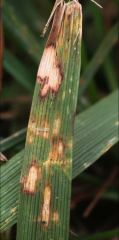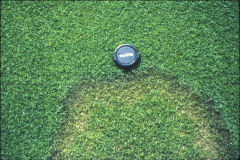![]()
![]()
![]()
Use LEFT and RIGHT arrow keys to navigate between flashcards;
Use UP and DOWN arrow keys to flip the card;
H to show hint;
A reads text to speech;
12 Cards in this Set
- Front
- Back
|
Brown patch symptom (cool season >1") |
Lesions are gray to brown, irregular in shape, and have a thin brown border. These lesions are the best diagnostic symptom of brown patch on tall fescue. |
|
|
Brown patch symptom (cool season >1") |

|
|
|
Brown patch (cool season >1")
Spore forming or non spore forming? |
Non-spore forming
Uses sclerotia to overwinter |
|
|
Brown patch (cool season >1")
Infection site and conditions? |
-Infects leaf sheaths
-Night temps above 60F
-Leaf wetness 10hrs+ |
|
|
Brown patch (cool season >1")
Most easily infected species? |
Tall fescue |
|
|
Brown patch (cool season >1")
Cultural mgmt. |
-Taller mowing height (2-3") enhances disease
-Avoid N application in summer
-Shade enhances disease -Avoid late irrigation |
|
|
Brown patch (cool season >1")
Chemical mgmt. |
Azoxystrobin
5 week interval throughout summer |
|
|
Brown patch (cool season <1")
Infected species |
Creeping bentgrass
perennial rye
annual bluegrass |
|
|
Brown patch (cool season <1")
symptoms |

Smoke ring
|
|
|
Brown patch (cool season <1") Cultural mgmt |
decrease N on high risk areas
avoid late irrigation
decrease shade, increase air circulation |
|
|
Brown patch (cool season <1") Chemical treatment |
azoxystrobin (penetrant
21-28 days of control |
|
|
Brown patch (cool season <1") Conditions |
Night time temps above 60F for 3-5 nights
(apply preventative fungicide at this time) |

